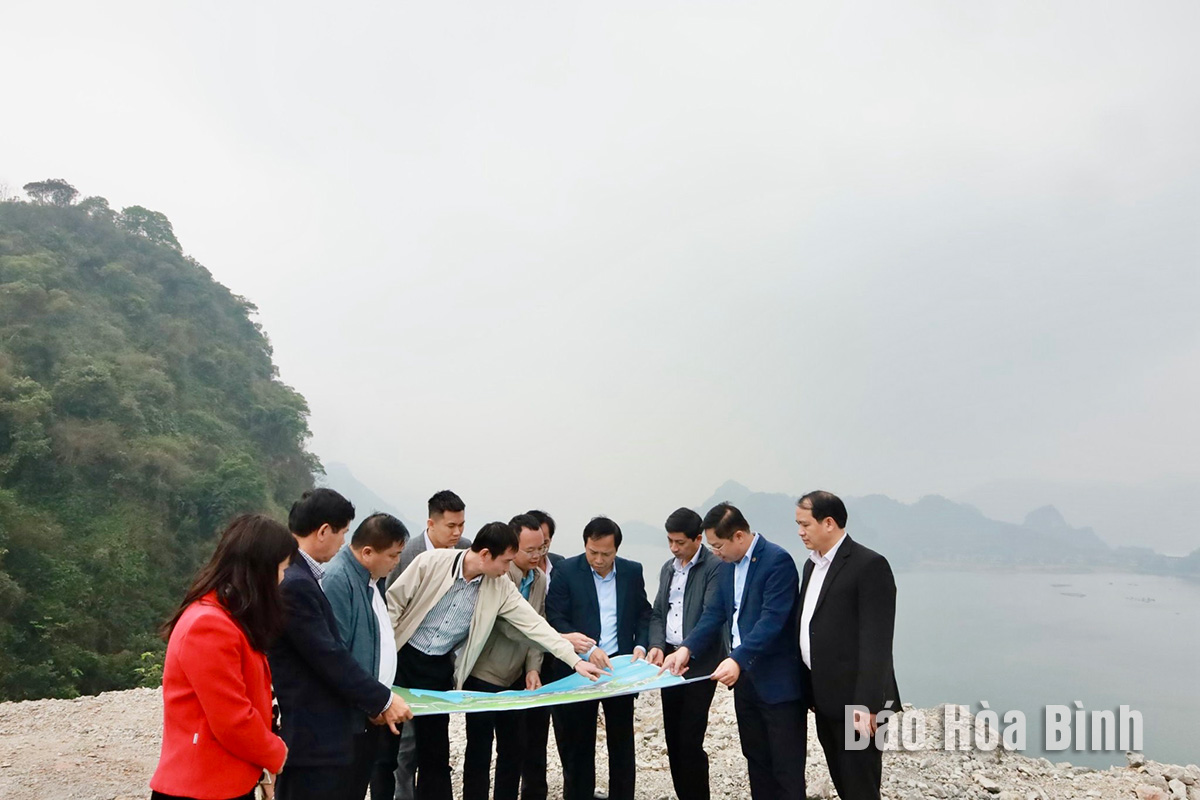
The Hoa Binh Lake tourism area is expected to become a national tourism site by 2030, focusing on developing synchronous and modern technical facilities, and high-quality and branded tourism products imbued with national cultural identities. The tourist site also aims to become the largest tourist centre in the province, and one of 12 key tourist areas in the Northern midland and mountainous region
Nguyen Van Toan,
Vice Chairman of the provincial People's Committee and leaders of departments
and sectors learn about difficulties and obstacles in implementing the Hoa Binh
Lake resort and eco-tourism project of Lac Hong JSC.
A community-based
tourist site in Sung village, Cao Son commune (Da Bac district).
According to the provincial Department of Planning and Investment, the Hoa Binh
Lake tourism area has 16 service, culture, and tourism investment projects
granted investment certificates worth over 3.3 trillion VND (132.3 million
USD), which cover an area of 1,444ha. Projects aim to meet the demand of resort tourism and entertainment service
associated with afforestation, forest protection, cultural identity
preservation, and spiritual tourism.
Although it has attracted several corporations and businesses to invest in
large-scale tourism projects, the implementation of projects remains slow, and
not guaranteed the committed schedule. Recently, to facilitate the implementation of key tourism investment projects,
particularly those within the Hoa Binh Lake tourism area, officials from the
provincial People's Committee and representatives of relevant departments and
agencies, inspected three large-scale investment projects in the site,
including the Binh Thanh eco-resort project by Mora Group JSC in Cao Phong
district, the Ngoi Hoa eco-tourism project by Hoang Son Energy
Investmentand TradingConstruction JSC, and the Hoa Binh Lake
ecotourism resort project by Lac Hong Investment JSC in Tan Lac district.
Nguyen Van Toan, Vice Chairman of the provincial People's Committee, affirmed
that the province will firmly direct all relevant agencies and departments to
provide maximum support in terms of procedures to ensure the progress of these
projects.
As scheduled, the Ngoi Hoa eco-tourism project’s first phase will be put into
operation in the third quarter of 2024, providing top-notch services. It is
expected to become an idealyear-rounddestination.
Construction of several other key projects is scheduled to commence this year,
promising to offer high-quality services such as yacht tours, kiteboarding,
paragliding, windsurfing, and a high-speed water park slide, outdoor swimming
pools, and beauty spa, among others.
In recent years, community-based tourism, sports tourism, and agricultural and
rural tourism in Hoa Binh have attracted the interest of young people and
foreign tourists.
Despite the impacts of the COVID-19 pandemic, tourism products and activities
in the Hoa Binh Lake tourism area have been resumed, and stably maintained.
Some tourism products have contributed to connecting road and waterway tourism
routes.
The tourism area is forecast to welcome over 500,000 visitors per year in the
coming years.
A diverse chain of eco-tourism and resort destinations concentrated in Hoa Binh city and the districts of Tan Lac, Da Bac, and Luong Son… Along with the launch of several key high-quality resort tourism projects, these developments have reshaped the landscape and enhanced the appeal of Hoa Binh as a travel destination.
Boasting diverse terrain, a mild climate, and rich natural resources, Cao Phong district is increasingly asserting its place on Vietnam’s tourism map, attracting both domestic and foreign visitors. The district is renowned for its stunning landscapes, majestic mountains, a crystal-clear hydropower lake, and the unique cultural identity of local ethnic groups.
With its pristine landscapes, unique cultural heritage of Muong ethnic minority, and an expanding range of visitor experiences, Tan Lac district of Hoa Binh has fast become a captivating destination for both domestic and international tourists.
Until now, Sung village in Cao Son commune, Da Bac district remains the only Dao ethnic community in Hoa Binh province to develop a community-based tourism model. Beyond its untouched natural landscapes, cultural identity serves as the cornerstone attraction for visitors.
Alongside the diverse cultural identities of the Kinh, Muong, Tay, Thai, Dao, and Mong ethnic people, Hoa Binh province is also renowned as the "capital" of the northwestern Vietnamese cuisine, offering unique and distinctive dishes. At festivals, during Lunar New Year (Tet), or on significant family or community occasions, special dishes are prepared, leaving a lasting impression on visitors.
A Phong Linh (Yellow Tabebuia) flower garden in Thang village, Thach Yen commune, Cao Phong district is currently in full bloom, drawing a large number of visitors.




